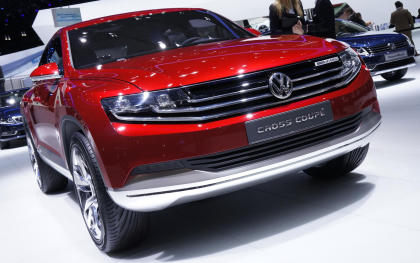 Press Association Motoring
Press Association MotoringGeneva Motor Show: Car gadgets of the future
One of the best things about the big car shows like Geneva is that you get to see genius at work, shaping our future driving lives with new technology. The big noises at the moment are all centred on the advancing technology under the bonnet.
Engines won’t be the same in five or 10 years. Even now, electrification is creeping into all manufacturers’ ranges and the systems are getting quite gadgety in themselves.

Take Volkswagen’s Cross Coupé range-extender hybrid concept, for example, with selectable driving modes for minimal energy use, full power, constant four-wheel drive and even one for recharging the battery packs fully, so they’re ready for an extended run on electric power alone.
[Related link:Buy new and used cars]
A similar system is already out there in Citroen and Peugeot’s Hybrid4 cars, and whatever misgivings you might have about having to get so involved, deliberately choosing specific driving modes according to the circumstances, it’s actually really good. It’s surprisingly satisfying in a techy sort of way.
But there’s plenty more cool technology on the way; you only need to have a glance at the concepts from the show to see that. One of the most extrovert is the Honda Diji, the outer skin of which is a giant, curvaceous screen that can display just about anything that can be put on a screen.

Imagine waking up and deciding you’d like your car to look like an image of the Milky Way galaxy. Find a picture online (via the car, because it’s clever like that) and the car will display it for all to see. Business logos, messages; you could do what you wanted – within the usual legal rules, mind you.
If you’re a little less interested in outer appearance and more interested in safety technology you be better off at the Kia stand, where you’ll find the UCD concept. It’s just a mock interior on the face of it, but under the skin it’s one of Kia’s ideas for saving lives and reducing accidents on the roads.
As well as a big touch-screen interface and head-up display there are infra-red LEDs and a camera to monitor the driver’s face, mainly watching for changes in eye movement. If your eyes are closed for too long ... well, Kia doesn’t say what happens to wake you up but let’s hope it’s not 40,000 volts through the seat.

Something a little more humble but no less brilliant has been brought to the fore by the new Ford Kuga. Destined for UK shores early next year you can open and close the tailgate by swiping a foot underneath the rear bumper. It’s simply genius for those times when your hands are full walking up the back of the car.
It’s just the first step in a series of technologies that will be movement-based. Imagine Xbox 360 Kinect but in your car. Mercedes is working on a system that uses hand movements to navigate through general menus to select music, for example. Designers love the idea because it frees the interior of switchgear and leaves much more room for originality.
Gadgets like that could remove the need for a dashboard in a conventional sense. Airbags could potentially be ejected from somewhere else, leaving much more room to make cars both smaller on the outside and bigger on the inside. The limit of what’s possible is defined largely by the rate at, and lengths to, which the public is willing to accept change. We Brits are rather well known for liking things the way they are, at least compared with the Japanese.
[Related link: Shop for car parts and gadgets online]
Whatever happens inside the car, as a continent we’re trying to use less oil and in anticipation of the rest of the world following suit, manufacturers’ efforts aren’t limited to fuel efficiency. Dunlop Goodyear is refining ways of making grippy, long-lasting tyres out of non oil-based products.
The BioIsoprene concept sees tyres made out of renewable biomass, which is a remarkable step forward if production can be scaled up and the tyres sold at a competitive price.
The idea is that these eco-friendly tyres would initially be produced for electric cars, so efforts are being made to make them particularly quiet and strong, to withstand the torque that electric cars transmit to the road.
Then there’s the company’s amazing ‘spring tyre’. Developed in co-operation with NASA, it features 800 springs mounted on a rim in such a way as to overlap and create a rounded, balloon tyre shape. Its applications are obvious for things like Mars landing craft where a puncture might be mission-ending, but Dunlop Goodyear is investigating how it can be used on our own planet.
Geneva 2012 has given the industry another chance to show the public what it’s up to. Some ideas will get canned after this while you’ll see others on family cars in a decade, and it’s that evolutionary process that makes the big motor shows fascinating.

 Yahoo News
Yahoo News 